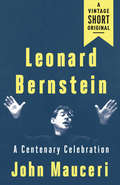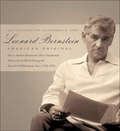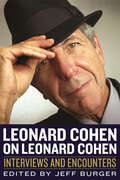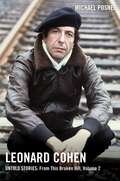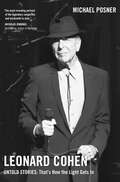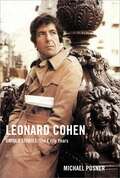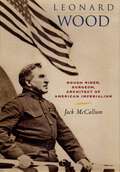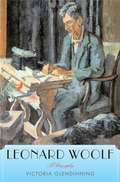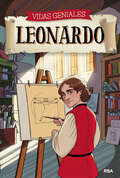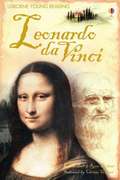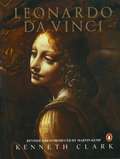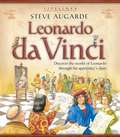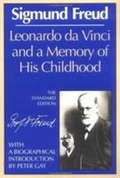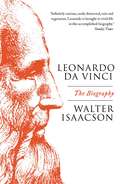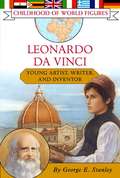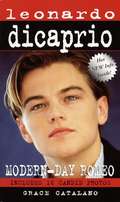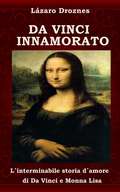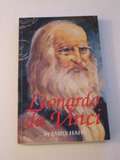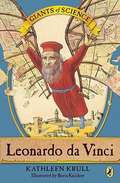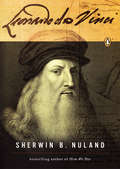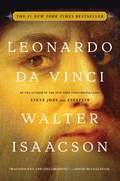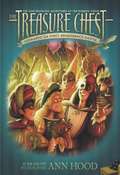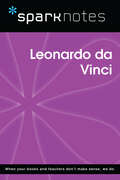- Table View
- List View
Leonard Bernstein: A Centenary Celebration (A Vintage Short)
by John MauceriA beautiful look into the life of one of our greatest and most famous musicians, Leonard Bernstein, from acclaimed conductor and musical director John Mauceri. A Vintage Shorts Original. An ebook short.
Leonard Bernstein: American Original
by Barbara Haws Burton BernsteinOne of the most gifted, celebrated, scrutinized, and criticized musicians in the second half of the twentieth century, Leonard Bernstein made his legendary conducting debut at the New York Philharmonic in 1943, at age 25. A year later, he became a sensation on Broadway with the premiere of On the Town. Throughout the 1950s, his Broadway fame only grew with Wonderful Town, Candide, and West Side Story. And in 1958, the Philharmonic appointed him the first American Music Director of a major symphony orchestra—a signal historical event. He was adored as a quintessential celebrity but one who could do it all—embracing both popular and classical music, a natural with the new medium of television, a born teacher, writer, and speaker, as well as a political and social activist. In 1976, having conducted the Philharmonic for more than one thousand concerts, he took his orchestra on tour to Europe for the last time.All of this played out against the backdrop of post-Second World War New York City as it rose to become the cultural capital of the world—the center of wealth, entertainment, communications, and art—and continued through the chaotic and galvanizing movements of the 1960s that led to its precipitous decline by the mid 1970s. The essays within this book do not simply retell the Bernstein story; instead, Leonard Bernstein's brother, Burton Bernstein, and current New York Philharmonic archivist and historian, Barbara B. Haws, have brought together a distinguished group of contributors to examine Leonard Bernstein's historic relationship with New York City and its celebrated orchestra. Composer John Adams, American historians Paul Boyer and Jonathan Rosenberg, music historians James Keller and Joseph Horowitz, conductor and radio commentator Bill McGlaughlin, musicologist Carol Oja, and music critics Tim Page and Alan Rich have written incisive essays, which are enhanced by personal reminiscences from Burton Bernstein. The result is a telling portrait of Leonard Bernstein, the musician and the man.
Leonard Cohen on Leonard Cohen: Interviews and Encounters
by Jeff BurgerLeonard Cohen, one of the most admired performers of the last half century, has had a stranger-than-fiction, roller-coaster ride of a life. Now, for the first time, he tells his story in his own words, via more than 50 interviews conducted worldwide between 1966 and 2012. In Leonard Cohen on Leonard Cohen--which includes a foreword by singer Suzanne Vega and eight pages of rarely seen photos--the artist talks about "Bird on the Wire," "Hallelujah," and his other classic songs. He candidly discusses his famous romances, his years in a Zen monastery, his ill-fated collaboration with producer Phil Spector, his long battle with depression, and much more. You'll find interviews that first appeared in the New York Times and Rolling Stone, but also conversations that have not previously been printed in English. Some of the material here has not been available until now in any format, including the many illuminating reminiscences that contributors supplied specifically for this definitive anthology.
Leonard Cohen, Untold Stories: From This Broken Hill, Volume 2 (Leonard Cohen, Untold Stories series #2)
by Michael PosnerThe second volume of the extraordinary life of the great music and literary icon Leonard Cohen, in the words of those who knew him best.Poet, novelist, singer-songwriter, artist, prophet, icon—there has never been a figure like Leonard Cohen. He was a true giant in contemporary western culture, entertaining and inspiring the world with his work. From his groundbreaking and bestselling novels, The Favourite Game and Beautiful Losers, to timeless songs such as &“Suzanne,&” &“Dance Me to the End of Love,&” and &“Hallelujah,&” Cohen is one of the world&’s most cherished artists. His death in 2016 was felt around the world by the many fans and followers who would miss his warmth, humour, intellect, and piercing insights. Leonard Cohen, Untold Stories chronicles the full breadth of his extraordinary life. This second of three volumes—From This Broken Hill—follows him from the conclusion of his first international music tour in 1971 as he continued to compose poetry, record music, and search for meaning into the late 1980s. The book explores his decade-long relationships with Suzanne Elrod, with whom he had two children, and various other numerous romantic partners, including the beginning of his long relationship with French photographer Dominique Issermann and, simultaneously, a five-year relationship with a woman never previously identified. It is a challenging time for Cohen. His personal life is in chaos and his career stumbles, so much so that his 1984 album, Various Positions, is rejected by Columbia Records, while other artistic endeavours fail to find an audience. However, this period also marks the start of his forty-year immersion in Zen Buddhism, which would connect him to the legendary Zen master Joshu Sasaki Roshi and inspire some of his most profound and enduring art. In From This Broken Hill, bestselling author and biographer Michael Posner draws on hundreds of interviews to reach beyond the Cohen of myth and reveal the unique, complex, and compelling figure of the real man. Honest and entertaining, this is a must-have book for any Cohen fan.
Leonard Cohen, Untold Stories: That's How the Light Gets In, Volume 3 (Leonard Cohen, Untold Stories series #3)
by Michael PosnerThe extraordinary life of one of the world&’s greatest music and literary icons, in the words of those who knew him best.Poet, novelist, singer-songwriter, artist, prophet, icon—there has never been a figure like Leonard Cohen. He was a true giant in contemporary western culture, entertaining and inspiring the world with his work. From his groundbreaking and bestselling novels, The Favourite Game and Beautiful Losers, to timeless songs such as &“Suzanne,&” &“Dance Me to the End of Love,&” and &“Hallelujah,&” Cohen is one of the world&’s most cherished artists. His death in 2016 was felt around the world by the many fans and followers who would miss his warmth, humour, intellect, and piercing insights. Leonard Cohen, Untold Stories chronicles the full breadth of his extraordinary life. This third and final volume in biographer Michael Posner&’s sweeping series of Cohen&’s life—That&’s How the Light Gets In—explores the last thirty years of his life, starting with the late 1980s revival of his music career with the successful albums I&’m Your Man and The Future. It covers the death of his manager, Marty Machat, and the appointment of another who would ultimately be accused of stealing more than five million dollars from Cohen. Personally, Cohen suffers the traumatic end of his long relationship with French photographer Dominique Issermann and begins a public romance with actress Rebecca De Mornay. When that relationship ends in 1993, as Cohen is about to turn sixty years old, he begins a deeply spiritual phase, entering the Mount Baldy monastery under the tutelage of Zen master Joshu Sasaki Roshi—arguably the most important relationship in Cohen&’s life. Ever the seeker, he then goes to Mumbai in 1999, the first of half a dozen trips to India to investigate Advaita Vedanta Hinduism, expanding his growing fascination with spirituality. In 2008, Cohen makes his triumphant return to the concert stage, and for five years travels the world in an extraordinary final act of his life, giving almost four hundred performances over three continents. The book provides the first full chronicle of Cohen&’s final months, fighting debilitating disease, while still creating three new studio albums, adding to his remarkable legacy. Cohen&’s story is told through the voices of those who knew him best—family and friends, colleagues and contemporaries, business partners and lovers. Bestselling author Michael Posner draws on hundreds of interviews to reveal the unique, complex, and compelling figure of the man The New York Times called &“a secular saint.&” This is a book like no other, about a man like no other.
Leonard Cohen, Untold Stories: The Early Years (Leonard Cohen, Untold Stories series #1)
by Michael PosnerThe extraordinary life of one of the world&’s greatest music and literary icons, in the words of those who knew him best.Poet, novelist, singer-songwriter, artist, prophet, icon—there has never been a figure like Leonard Cohen. He was a true giant in contemporary western culture, entertaining and inspiring people everywhere with his work. From his groundbreaking and bestselling novels, The Favourite Game and Beautiful Losers, to timeless songs such as &“Suzanne,&” &“Dance Me to the End of Love,&” and &“Hallelujah,&” Cohen is a cherished artist. His death in 2016 was felt around the world by the many fans and followers who would miss his warmth, humour, intellect, and piercing insights. Leonard Cohen, Untold Stories chronicles the full breadth of his extraordinary life. The first of three volumes—The Early Years—follows him from his boyhood in Montreal to university, and his burgeoning literary career to the world of music, culminating with his first international tour in 1970. Through the voices of those who knew him best—family and friends, colleagues and contemporaries, rivals, business partners, and his many lovers—the book probes deeply into both Cohen&’s public and private life. It also paints a portrait of an era, the social, cultural, and political revolutions that shook the 1960s. In this revealing and entertaining first volume, bestselling author and biographer Michael Posner draws on hundreds of interviews to reach beyond the Cohen of myth and reveal the unique, complex, and compelling figure of the real man.
Leonard Wood: Rough Rider, Surgeon, Architect of American Imperialism
by Jack McCallumOne of the most fascinating but least remembered figures in modern American history, Major General Leonard Wood (1860-1927) was, with his close friend Theodore Roosevelt, an icon of U.S. imperialism as the nation evolved into a global power at the dawn of the twentieth century. The myriad of roles that Wood played in his extraordinary career offer a mirror image of the country's expansion from the urban Northeast to the western frontier to Latin America and the Far East. Boston surgeon, Indian fighter, U.S. Army Chief of Staff, Medal of Honor winner, commander of the Rough Riders in the Spanish-American War, Governor General of the Philippines, and presidential candidate, Wood was one of a select cadre of men that transformed the American military at the turn of the century, turning it into a modern fighting force and the nation into a world power.Throughout his life, Wood tested the division between military and civilian power to its very limits. His 1920 presidential campaign and his conflicts with civilian politicians were harbingers of the struggles that Generals Douglas MacArthur and Dwight D. Eisenhower would face as they moved from the battlefield to Washington following World War II.Jack McCallum has mined Wood's extensive personal records—including diaries, correspondence, and photographs—to create a vivid portrait of a complex man and the legacy he left on U.S. imperialism. America's rapid conquest of Cuba and the Philippines and the subsequent political and economic reconstruction it imposed under Wood's military supervision in these regions have important parallels to current U.S. involvement in the Middle East, both in its successes and its failures.
Leonard Woolf
by Victoria GlendinningAward-winning biographer Victoria Glendinning draws on her deep knowledge of the twentieth century literary scene, and on her meticulous research into previously untapped sources, to write the first full biography of the extraordinary man who was the "dark star" at the center of the Bloomsbury set, and the definitive portrait of the Woolf marriage. A man of extremes, Leonard Woolf was ferocious and tender, violent and self-restrained, opinionated and nonjudgmental, always an outsider of sorts within the exceptionally intimate, fractious, and sometimes vicious society of brilliant but troubled friends and lovers. He has been portrayed either as Virginia's saintly caretaker or as her oppressor, the substantial range and influence of his own achievements overshadowed by Virginia's fame and the tragedy of her suicide. But Leonard was a pivotal figure of his age, whose fierce intelligence touched the key literary and political events that shaped the early decades of the twentieth century and would resonate into the post-World War II era. Glendinning beautifully evokes Woolf 's coming-of-age in turn-of-the-century London. The scholarship boy from a prosperous Jewish family would cut his own path through the world of the British public school, contending with the lingering anti-Semitism of Imperial Age Britain. Immediately upon entering Trinity College, Cambridge, Woolf became one of an intimate group of vivid personalities who would form the core of the Bloomsbury circle: the flamboyant Lytton Strachey; Toby Stephen, "the Goth," through whom Leonard would meet Stephen's sister Virginia; and Clive Bell. Glendinning brings to life their long nights of intense discussion of literature and the vicissitudes of sex, and charts Leonard's course as he becomes the lifelong friend of John Maynard Keynes and E. M. Forster. She unearths the crucial influence of Woolf 's seven years as a headstrong administrator in colonial Ceylon, where he lost confidence in the imperial mission, deciding to abandon Ceylon in order to marry the psychologically troubled Virginia Stephen. Glendinning limns the true nature of Leonard's devotion to Virginia, revealing through vivid depiction of their unconventional marriage how Leonard supported Virginia through her breakdowns and in her writing. In co-founding with Virginia the Hogarth Press, he provided a secure publisher for Virginia's own boldly experimental works. As the éminence grise of the early Labour Party, working behind the scenes,Woolf became a leading critic of imperialism, and his passionate advocacy of collective security to prevent war underpinned the charter of the League of Nations. After Virginia's death, he continued to forge his own iconoclastic way, engaging in a long and happy relationship with a married woman. Victoria Glendinning's Leonard Woolf is a major achievement -- a shrewdly perceptive and lively portrait of a complex man of extremes and contradictions in whom passion fought with reason and whose far-reaching influence is long overdue for the full appreciation Glendinning offers in this important book.
Leonard Woolf
by Victoria GlendinningAward-winning biographer Victoria Glendinning draws on her deep knowledge of the twentieth century literary scene, and on her meticulous research into previously untapped sources, to write the first full biography of the extraordinary man who was the "dark star" at the center of the Bloomsbury set, and the definitive portrait of the Woolf marriage. A man of extremes, Leonard Woolf was ferocious and tender, violent and self-restrained, opinionated and nonjudgmental, always an outsider of sorts within the exceptionally intimate, fractious, and sometimes vicious society of brilliant but troubled friends and lovers. He has been portrayed either as Virginia's saintly caretaker or as her oppressor, the substantial range and influence of his own achievements overshadowed by Virginia's fame and the tragedy of her suicide. But Leonard was a pivotal figure of his age, whose fierce intelligence touched the key literary and political events that shaped the early decades of the twentieth century and would resonate into the post-World War II era. Glendinning beautifully evokes Woolf 's coming-of-age in turn-of-the-century London. The scholarship boy from a prosperous Jewish family would cut his own path through the world of the British public school, contending with the lingering anti-Semitism of Imperial Age Britain. Immediately upon entering Trinity College, Cambridge, Woolf became one of an intimate group of vivid personalities who would form the core of the Bloomsbury circle: the flamboyant Lytton Strachey; Toby Stephen, "the Goth," through whom Leonard would meet Stephen's sister Virginia; and Clive Bell. Glendinning brings to life their long nights of intense discussion of literature and the vicissitudes of sex, and charts Leonard's course as he becomes the lifelong friend of John Maynard Keynes and E. M. Forster. She unearths the crucial influence of Woolf 's seven years as a headstrong administrator in colonial Ceylon, where he lost confidence in the imperial mission, deciding to abandon Ceylon in order to marry the psychologically troubled Virginia Stephen. Glendinning limns the true nature of Leonard's devotion to Virginia, revealing through vivid depiction of their unconventional marriage how Leonard supported Virginia through her breakdowns and in her writing. In co-founding with Virginia the Hogarth Press, he provided a secure publisher for Virginia's own boldly experimental works. As the éminence grise of the early Labour Party, working behind the scenes,Woolf became a leading critic of imperialism, and his passionate advocacy of collective security to prevent war underpinned the charter of the League of Nations. After Virginia's death, he continued to forge his own iconoclastic way, engaging in a long and happy relationship with a married woman. Victoria Glendinning's Leonard Woolf is a major achievement -- a shrewdly perceptive and lively portrait of a complex man of extremes and contradictions in whom passion fought with reason and whose far-reaching influence is long overdue for the full appreciation Glendinning offers in this important book.
Leonard Woolf: A Biography
by Victoria GlendinningAward-winning biographer Victoria Glendinning draws on her deep knowledge of the twentieth century literary scene, and on her meticulous research into previously untapped sources, to write the first full biography of the extraordinary man who was the "dark star" at the center of the Bloomsbury set, and the definitive portrait of the Woolf marriage. A man of extremes, Leonard Woolf was ferocious and tender, violent and self-restrained, opinionated and nonjudgmental, always an outsider of sorts within the exceptionally intimate, fractious, and sometimes vicious society of brilliant but troubled friends and lovers. He has been portrayed either as Virginia's saintly caretaker or as her oppressor, the substantial range and influence of his own achievements overshadowed by Virginia's fame and the tragedy of her suicide. But Leonard was a pivotal figure of his age, whose fierce intelligence touched the key literary and political events that shaped the early decades of the twentieth century and would resonate into the post-World War II era. Glendinning beautifully evokes Woolf 's coming-of-age in turn-of-the-century London. The scholarship boy from a prosperous Jewish family would cut his own path through the world of the British public school, contending with the lingering anti-Semitism of Imperial Age Britain. Immediately upon entering Trinity College, Cambridge, Woolf became one of an intimate group of vivid personalities who would form the core of the Bloomsbury circle: the flamboyant Lytton Strachey; Toby Stephen, "the Goth," through whom Leonard would meet Stephen's sister Virginia; and Clive Bell. Glendinning brings to life their long nights of intense discussion of literature and the vicissitudes of sex, and charts Leonard's course as he becomes the lifelong friend of John Maynard Keynes and E. M. Forster. She unearths the crucial influence of Woolf 's seven years as a headstrong administrator in colonial Ceylon, where he lost confidence in the imperial mission, deciding to abandon Ceylon in order to marry the psychologically troubled Virginia Stephen. Glendinning limns the true nature of Leonard's devotion to Virginia, revealing through vivid depiction of their unconventional marriage how Leonard supported Virginia through her breakdowns and in her writing. In co-founding with Virginia the Hogarth Press, he provided a secure publisher for Virginia's own boldly experimental works. As the éminence grise of the early Labour Party, working behind the scenes,Woolf became a leading critic of imperialism, and his passionate advocacy of collective security to prevent war underpinned the charter of the League of Nations. After Virginia's death, he continued to forge his own iconoclastic way, engaging in a long and happy relationship with a married woman. Victoria Glendinning'sLeonard Woolfis a major achievement -- a shrewdly perceptive and lively portrait of a complex man of extremes and contradictions in whom passion fought with reason and whose far-reaching influence is long overdue for the full appreciation Glendinning offers in this important book.
Leonardo
by Meritxell Margarit¿Te apuntas a descubrir su verdadera historia? La vida del mayor genio del Renacimiento en una edición ilustrada por Lola Rodríguez. Leonardo fue uno de los grandes genios de la historia: pintó increíbles obras, como la Mona Lisa, e inventó fantásticos artilugios, como la máquina de vuelo. Pero también fue un joven inquieto, curioso y bromista, que se atrevió a imaginar un mundo nuevo, donde arte, ciencia y fantasía iban de la mano.
Leonardo Da Vinci
by Kenneth Clark Martin KempA personally compelling introduction to Leonardo's genius, a classic monograph of Leonardo's art and his development.
Leonardo Da Vinci
by Steve AugardeThis illustrated biography series combines non-fiction and fiction to introduce readers to famous historical characters. Each book begins with a diary, told from the point of view of a child who works for the famous person. At the end of each book there is an illustrated reference chapter.
Leonardo Da Vinci and a Memory of His Childhood
by Sigmund FreudA detailed reconstruction of Leonardo's emotional life from his earliest years, it represents Freud's first sustained venture into biography from a psychoanalytic perspective, and also his effort to trace one route that homosexual development can take.
Leonardo Da Vinci: Cong Fan Ren Dao Tian Cai De Chuang Zao Li Mi Ma = Leonardo Da Vinci
by Walter Isaacson'To read this magnificent biography of Leonardo da Vinci is to take a tour through the life and works of one of the most extraordinary human beings of all time in the company of the most engaging, informed, and insightful guide imaginable. Walter Isaacson is at once a true scholar and a spellbinding writer. And what a wealth of lessons there are to be learned in these pages.' David McCullough Based on thousands of pages from Leonardo&’s astonishing notebooks and new discoveries about his life and work, Walter Isaacson weaves a narrative that connects his art to his science. He shows how Leonardo&’s genius was based on skills we can improve in ourselves, such as passionate curiosity, careful observation, and an imagination so playful that it flirted with fantasy. He produced the two most famous paintings in history, The Last Supper and the Mona Lisa. But in his own mind, he was just as much a man of science and technology. With a passion that sometimes became obsessive, he pursued innovative studies of anatomy, fossils, birds, the heart, flying machines, botany, geology, and weaponry. His ability to stand at the crossroads of the humanities and the sciences, made iconic by his drawing of Vitruvian Man, made him history&’s most creative genius. His creativity, like that of other great innovators, came from having wide-ranging passions. He peeled flesh off the faces of cadavers, drew the muscles that move the lips, and then painted history&’s most memorable smile. He explored the math of optics, showed how light rays strike the cornea, and produced illusions of changing perspectives in The Last Supper. Isaacson also describes how Leonardo&’s lifelong enthusiasm for staging theatrical productions informed his paintings and inventions. Leonardo&’s delight at combining diverse passions remains the ultimate recipe for creativity. So, too, does his ease at being a bit of a misfit: illegitimate, gay, vegetarian, left-handed, easily distracted, and at times heretical. His life should remind us of the importance of instilling, both in ourselves and our children, not just received knowledge but a willingness to question it—to be imaginative and, like talented misfits and rebels in any era, to think different.
Leonardo Da Vinci: Young Artist, Writer, and Inventor
by George E. StanleyThis book is a biography of Leonardo Da Vinci, best known as the Renaissance painter who created the "Mona Lisa" and "The Last Supper" and also made great contributions as a sculptor, architect, engineer and scientist.
Leonardo DiCaprio, Modern-day Romeo
by Grace CatalanoBiography of the famous actor, star of the movie Titanic
Leonardo Innamorato
by Lázaro Droznes Federica CostaLeonardo da Vinci riceve nella sua bottega di Firenze Monna Lisa Gherardini al fine di realizzare un ritratto ordinato dal marito. Da Vinci trattiene il dipinto in suo potere; non arriverà mai a consegnarlo al cliente per portarlo con sé in ogni suo trasferimento fino alla fine dei suoi giorni. Fu un lungo idillio con la donna ideale, prolungatosi per il resto della sua vita, nel corso di vent'anni di costanti ritocchi. La presente finzione drammatica ricrea il rapporto di Leonardo con la Gioconda, con il suo assistente Salaì e con la natura, nella sua ricerca della verità e della bellezza. La pittura continua ad appassionare dopo svariati secoli l'intera umanità, ponendo le stesse domande che si sarà posto Da Vinci: perché sorride La Gioconda? Quale mistero cela questa donna? Quale mistero celano le donne? Come avrebbe detto il gran Leonardo: "la bellezza è verità e la verità è bellezza". Quest'opera tenta di penetrare in questi misteri che impregnano l'intera opera di Da Vinci.
Leonardo da Vinci
by Emily HahnLeonardo's interests and achievements spread far beyond the world of art. He studied astronomy, botany, anatomy, and geology, and designed and drew plans for hundreds of inventions, many of which fore-shadowed the achievements of men who lived four hundred years after Leonardo died. Emily Hahn brings this quintessential Renaissance Man to life in her delightful and easy to read biography.
Leonardo da Vinci
by Kathleen KrullLeonardo da Vinci's notebooks are mind-boggling evidence of a fifteenth-century scientific genius standing at the edge of the modern world, basing his ideas on observation and experimentation. This book will change children's ideas of who Leonardo was and what it means to be a scientist. .
Leonardo da Vinci
by Nuland Sherwin B.Leonardo da Vinci (1452-1519) is the Italian painter, draftsman, sculptor, architect, and engineer whose genius, perhaps more than that of any figure, epitomized the Renaissance humanist ideal. His Last Supper (1495-97) and Mona Lisa (1503-06) are among the most widely popular and influential paintings of the Renaissance, while his notebooks reveal a spirit of scientific inquiry and a mechanical inventiveness that were centuries ahead of their time. What was it that propelled Leonardo's insatiable curiosity? How could the same person, in the same moment, appear to be as naive as a child yet as profound as a sage? What was it that was truly 'modern' about this mind and work? Nuland finds clues in Leonardo's art, his scientific research, his famous notebooks and in his relationships with his family, patrons and lovers.
Leonardo da Vinci
by Walter Isaacson<P>He was history’s most creative genius. What secrets can he teach us? The author of the acclaimed bestsellers Steve Jobs, Einstein, and Benjamin Franklin brings Leonardo da Vinci to life in this exciting new biography. <P>Based on thousands of pages from Leonardo’s astonishing notebooks and new discoveries about his life and work, Walter Isaacson weaves a narrative that connects his art to his science. He shows how Leonardo’s genius was based on skills we can improve in ourselves, such as passionate curiosity, careful observation, and an imagination so playful that it flirted with fantasy. He produced the two most famous paintings in history, The Last Supper and the Mona Lisa. But in his own mind, he was just as much a man of science and technology. <P>With a passion that sometimes became obsessive, he pursued innovative studies of anatomy, fossils, birds, the heart, flying machines, botany, geology, and weaponry. His ability to stand at the crossroads of the humanities and the sciences, made iconic by his drawing of Vitruvian Man, made him history’s most creative genius. His creativity, like that of other great innovators, came from having wide-ranging passions. He peeled flesh off the faces of cadavers, drew the muscles that move the lips, and then painted history’s most memorable smile. He explored the math of optics, showed how light rays strike the cornea, and produced illusions of changing perspectives in The Last Supper. <P>Isaacson also describes how Leonardo’s lifelong enthusiasm for staging theatrical productions informed his paintings and inventions. Leonardo’s delight at combining diverse passions remains the ultimate recipe for creativity. So, too, does his ease at being a bit of a misfit: illegitimate, gay, vegetarian, left-handed, easily distracted, and at times heretical. His life should remind us of the importance of instilling, both in ourselves and our children, not just received knowledge but a willingness to question it—to be imaginative and, like talented misfits and rebels in any era, to think different. <P><b>A New York Times Bestseller</b>
Leonardo da Vinci #9
by Ann Hood Denis ZilberTravel back in time to Renaissance Italy with the Robbins twins! In book nine of The Treasure Chest, Maisie and Felix continue to learn the magic of Elm Medona and the Pickworth family history. In the latest adventure, the twins travel to fifteenth- century Italy and meet a young Leonardo da Vinci. Every Treasure Chest book features a biography of the featured historical figure along with Ann's Favorite Facts from her research!
Leonardo da Vinci (SparkNotes Biography Guide)
by SparkNotesLeonardo da Vinci (SparkNotes Biography Guide) Making the reading experience fun! SparkNotes Biography Guides examine the lives of historical luminaries, from Alexander the Great to Virginia Woolf. Each biography guide includes:An examination of the historical context in which the person lived A summary of the person&’s life and achievements A glossary of important terms, people, and events An in-depth look at the key epochs in the person&’s career Study questions and essay topics A review test Suggestions for further reading Whether you&’re a student of history or just a student cramming for a history exam, SparkNotes Biography guides are a reliable, thorough, and readable resource.
